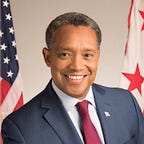From Bondage to Freedom: Commemorating DC Emancipation Day
This Saturday marks DC Emancipation Day, the 160th anniversary of a momentous day in our local history. On April 16, 1862, President Abraham Lincoln signed a bill ending slavery in the District of Columbia. For the over 3,000 slaves in DC, emancipation marked a turning point in their lives–and what they thought was possible for their future.
Like other cities across the south, slavery was woven into the fabric of DC from the very beginning. In fact, DC was one of the busiest slave depots in the entire country. This is a history that is tough to reckon with — but it is necessary to understand the struggles of past Washingtonians, and for many Black Washingtonians, the struggles of their ancestors. Due to the location of the District–sandwiched between two slaveholding states of Maryland and Virginia–the slave trade flourished. So much so, that by 1800, the number of enslaved Blacks outnumbered free Blacks in the District — with about 4,000 enslaved people and 500 free Blacks living in the city.
On the streets we walk today, slaves were crammed into pens and prisons like animals before they were sold. Slave coffles–groups of people chained together in a line–were regularly escorted through downtown. Countless members of Congress and twelve out of the first eighteen presidents were slaveholders, giving the terrible practice approval by some of the country’s most powerful leaders.
By 1850, the enslaved population in DC shrank to roughly 3,185 people as a result of the Compromise of 1850 — outlawing the slave trade in the District. But even free Black people did not have true “freedom.” Free Blacks were required to carry around a “certificate of freedom.” Without these papers, they could be thrown in jail or sold into slavery.
With the District of Columbia Compensated Emancipation Act, that came to an end — but the Act was not without injustices. In fact, the Act compensated former enslavers and encouraged newly emancipated slaves to leave the District. This was hardly ideal for recently freed Blacks trying to chart a new future. As emancipation proved, freedom alone was not enough to advance the economic and civil rights of Black Washingtonians.
Nevertheless, DC residents celebrated intensely in Franklin Square — named for Benjamin Franklin, a slaveholder who later in life became an abolitionist. According to local historian Derek Musgrove’s book, Chocolate City, the celebration was a “powerful, public manifestation of the almost unimaginable change Washington had experienced since the beginning of the [Civil] war.” Participation in full economic and civic life–while still challenging–was now a real possibility for freed slaves eager be part of democracy.
Washington DC has–and always will–represent America’s highest ideals of freedom, equality, and justice. In the same spirit of the brave abolitionists, slaves, and free Blacks who demanded freedom and made Emancipation Day possible, today, let’s commit ourselves to demanding a more just future.
We still have plenty of work to do.
